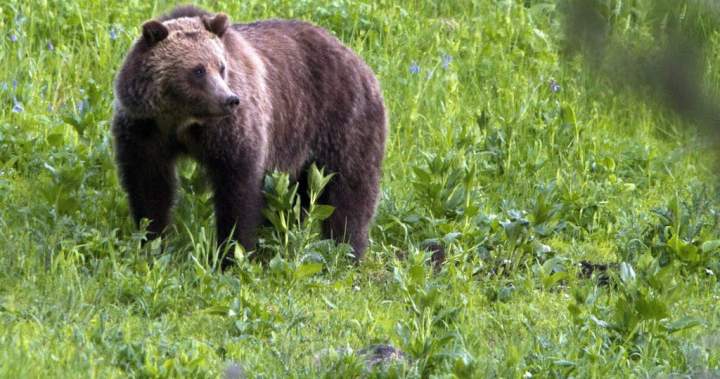An effort by the Alberta government to protect its grizzly bear population may be too successful.
A number of close calls and videos showing the animals near livestock have some musing about reinstating the long-banned grizzly hunt.
Nicholas Lagarde, who has been a rancher near Pincher Creek, Alta., for six years now, says he’s never seen as many grizzly bears on his property as he has in the last few months.
“This year has been the craziest for us. We’ve seen 16 individual grizzly bears,” he said.
“Everyone has seen that the population has now increased and now there’s definitely a lot more conflicts in the area.”
His livestock guardian dog, Fenrir, is specially trained to keep his cattle safe. Still, there have been close calls, including last spring when a bear charged at Lagarde’s fiancée, Sophie Noelkes, and several calves.
Story continues below advertisement
“When I saw (the bear) coming uphill, he was standing on his back legs and looked super scary and Fenrir had to attack or started chasing him away,” said Noelkes.
The province has had a ban on hunting grizzly bears since 2006, however a wildlife management program introduced in 2024 allowed for the killing of “problem grizzlies.”
One bear has been killed so far under that program, but the minister in charge believes more should be done.
Get daily National news
Get the day’s top news, political, economic, and current affairs headlines, delivered to your inbox once a day.
“There’s definitely grizzly bears that are moving into areas (where) we haven’t seen them for quite some time and so it does appear like the population is rising and the distribution of them is spreading,” said Minister of Forestry and Parks Todd Loewen.
More on Calgary
More videos
“We want to make sure that we keep Albertans safe.”
But when asked whether government was considering lifting the grizzly bear hunt ban, Loewen said, “We don’t have any plans of doing that at this time.”
The province went on to say there are other options aside from a hunt, including an effort to enhance bear habitats to entice the animals away from campgrounds and farms.
Recent attacks
Lethbridge, Alta. couple Doug Inglis and Jenny Gusse were killed in a bear attack while hiking in Banff National Park in October 2023.
Story continues below advertisement
In August of this year, Min. Loewen said a fisher was attacked by a grizzly bear near Milk River, 300 km south of Calgary.
More recently, a hunter was rushed to hospital by air ambulance a week ago after being attacked by a grizzly bear south of Cochrane, Alta. Another hunter shot the bear, which was believed to have died.
A second bear, however, fled the area after the encounter.
Trending Now
-
Budget 2025 made some changes to tax policy. What does it mean for you?
-
California Republicans sue over new U.S. House map approved by voters
Kim Tichener, owner of the company Bear Safety and More, told Global News it’s no surprise that some bears are still out and haven’t gone into hibernation yet.
“It varies each season. If we have vegetation stay out longer, we have a warmer fall. We’re going to have bears out for a longer period,” said Tichener.
2:11
Alberta hunter recalls own grizzly bear close call, urges hunting safety
No accurate count
Further complicating matters, Alberta doesn’t have an accurate count on how much the bear population has grown because it’s been several years since a count was conducted.
Story continues below advertisement
“It seems the population now is about 900, maybe 950 individuals. Nobody knows for sure,” said biologist, Colleen St. Clair, from the University of Alberta in Edmonton.
“From a population and conservation perspective, we have a ways to go until grizzly bears can be considered recovered in Alberta.”
But out on the ridge, Lagarde and his fellow ranchers and neighbours have a different point of view.
“I think now is the time to look at introducing a sustainable hunt to manage the population,” he said.
— with a file from Ken MacGillivray
© 2025 Global News, a division of Corus Entertainment Inc.





